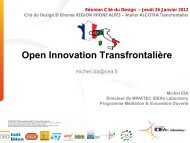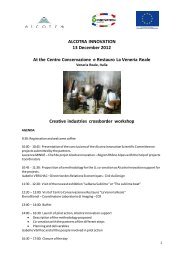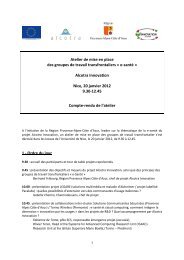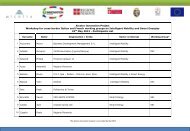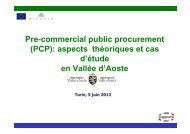Best practices Database for Living Labs - ALCOTRA - Innovation
Best practices Database for Living Labs - ALCOTRA - Innovation
Best practices Database for Living Labs - ALCOTRA - Innovation
You also want an ePaper? Increase the reach of your titles
YUMPU automatically turns print PDFs into web optimized ePapers that Google loves.
8. Ownership of existing <strong>Living</strong> Lab <strong>Best</strong> Practice data<br />
As stated above, the existing database was developed as part of the Corelabs and Collabs project. The<br />
Corelabs project trigger in the beginning an Idea that a <strong>for</strong>mal framework should exists in which living labs<br />
could exchange ideas and experiences. It became very early evident that the living lab understanding was<br />
sometimes totally different from what was defined as a framework as part of the work in Corelabs, mainly<br />
defining a <strong>Living</strong> lab as an innovation environment with a strong user/citizen involvement and focus. In<br />
order to, on the one hand broaden the <strong>Living</strong> Lab community while at the same time trying to narrow the<br />
scope of the living lab, thematic calls <strong>for</strong> living lab partnership were published in different waves usually<br />
once a year. In order <strong>for</strong> a living lab to become part of the European Network of <strong>Living</strong> <strong>Labs</strong> an application<br />
<strong>for</strong>m had to be filled out. The different calls <strong>for</strong> membership led to an development which now represent s<br />
the ENoLL with all it’s members. In this context it is important that the usage of the application data (that<br />
was handed in by the <strong>Living</strong> Lab applicants) was never discussed in detail nor did the application <strong>for</strong>m as<br />
such gave any hints on how the data handed over by applying <strong>for</strong> an EnoLL membership were to be used. A<br />
matter of fact though is, that the first 3 calls and the respective evaluations of the applications where<br />
conducted as part of the Project Corelabs and Collabs, thus application handed in under the respective 3<br />
calls need to be connected to the projects and their related project consortia, while the last two calls (4 th<br />
and 5ht wave) were conducted by the ENoLL organization/company. Thus the owner ship of the data<br />
received in the last two calls could reside with the ENoLL company. In any case as long as these issues are<br />
not clarified the data can’t be accesses publicly and thus the <strong>Database</strong> usage is at this time only <strong>for</strong><br />
research purposes conducted at the FHV.<br />
9. Structure of current <strong>Database</strong><br />
As pointed out above, the database consists currently out of the application in<strong>for</strong>mation that is divided into<br />
several subsections mainly consisting out of a section which can be identified as administrative data and a<br />
section that deals with the content of the <strong>Living</strong> Lab. The database was build up from the application <strong>for</strong>ms<br />
that were submitted either as Word-file or as PDF. Thus the database consists out of one table which<br />
consists out of the following attributes:<br />
• LLUser<br />
• LLPassword<br />
• LLFullName<br />
• LLPostalAddress<br />
• LLZipCode<br />
• LLCountry<br />
• LLTelephone<br />
• LLFax<br />
• LLWebSite<br />
The project is co-funded by the ERDF<br />
Page 63 of 78



